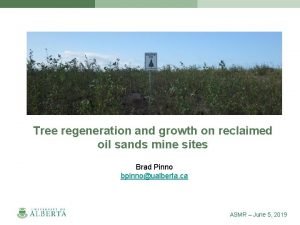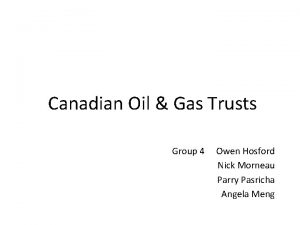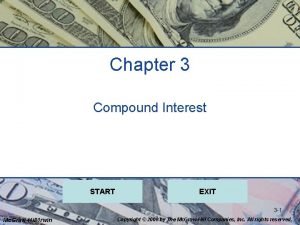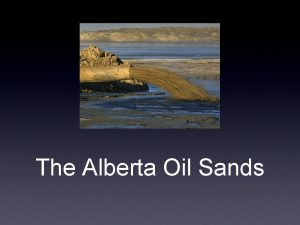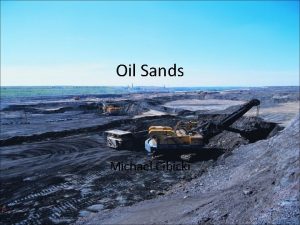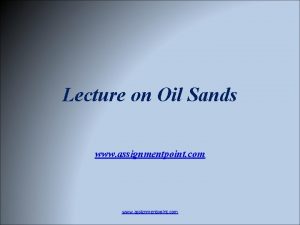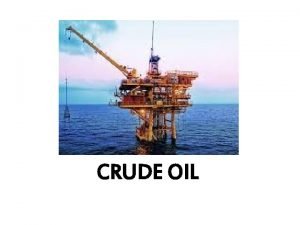The Canadian Oil Sands The US consumes annually















- Slides: 15

The Canadian Oil Sands • The US consumes annually 7 x 108 bbl oil • The Alberta Canada (Atabascan) oil (tar) sands contain ~2 x 1011 bbl oil, recoverable at current price, matching the recoverable reserves of Saudi Arabia • The 2005 Albertan tar oil production was 4 x 108 bbl

Economic History of the Canadian Oil Sands • Commercial production of oil from the Athabasca oil sands began in 1967, when Suncor opened its first mine. Development was soon inhibited by declining world oil prices. • The second mine, operated by Syncrude, began operating in 1978. As the price of oil subsided after the Arab oil embargo, the plug was again pulled on new developments. • The third mine, operated by Shell Canada started operating only in 2003. • With the 2004 -2006 oil price increases, and the production cost being $ 35 -$ 38, the existing mines have been greatly expanded and new ones are being planned

Where Will the Tar Oil Go? • An agreement has been signed between Petro. China and Enbridge to build a 400, 000 barrel-per-day pipeline from Edmonton, Alberta to the west-coast port of Kitimat BC to export synthetic crude oil from the oil sands to China plus a 150, 000 bpd pipeline running the other way to import condensate to dilute the bitumen so it will flow. • Sinopec, China's largest refining and chemical company, and China National Petroleum Corporation have bought shares in major oil sands companies • India invested $1 billion in the Athabasca Oil Sands in 2006. Four Indian companies are involved





The Oil Sand Crude: Bitumen

Reducing the Quantity of Methane Required Froth Production and Separation; Breaking the Water-in-Bitumen Emulsion • Facilitate production of the bitumen-carrying froth, produced by injecting steam into the tar sand • Accelerate the phase separation of the froth • De-emulsify the residual water in the separated bitumen, as salt and colloidal clay particle containing 3 -5 μm diameter droplets of water remaining in the separated bitumen cause equipment corrosion

Sand-Oil RD&E Needs • Tailings management: nanoparticle suspension processing, separation, characterization • Materials: wear and corrosion by colloids • Process control: equipment for, monitoring of, and algorithms for processing colloids • Bitumen: chemistry, reactions, processing

Tailings Management • Slow-settling, clay particles of the oil sand are dispersed in water in the bitumen extraction process • Because the particles are hydrophilic, a “mature fine tailing”, a particle loaded, oil containing, hydrogel, is formed • The Challenge: Collapse the gel to aggregate the dispersed particles and release the water for treatment by an already practiced microbiological effluent-treatment process. Necessary to alleviate the severe environmental impact

# 1 Item on the Tar Oil Industry Wish List Low cost catalyst, mixed in the injected steam, accelerating the reaction of bitumen with steam to yield lower molecular weight (and therefore less viscous, easier to volatilize, easier to separate) crude oil

Shale Oil • Oil shales are rocks rich in organic matter (kerogen) • The oil is derived through retorting, i. e. pyrolysis in the absence of air, at 445 -500 °C • The worldwide reserves of oil shale are estimated at 2. 6 trillion barrels of recoverable oil. 1. 0 -1. 2 trillion barrels are in the US • Oil shale is can be burnt as is, but it is a low-grade fuel • Oil shale is currently mined in Estonia, Brazil and China

History of US Shale Oil 1964 -1980 On-Again, Off Again • 1964 Colony oil shale project of Tosco, Sohio and Cleveland Cliffs • 1972 Colony oil shale project halted after 270, 000 bbls were produced. Occidental Petroleum conducts in-situ oil shale experiments at Logan, WA. Shell researches Piceance Creek in-situ steam injection process for oil shale. Oil drops $ 20/bbl • 1974 Unocal develops new “Union B” retort process; Shell and Ashland join Colony Project. Oil prices increase, at $41/bbl • 1976 Unocal begins planning commercial scale plant at Parachute Creek to be built when investment is economical • 1977 Oil prices drop. Superior Oil abandons plan for Meeker oil shale plant planned since 1972 • 1979 Shell, Ashland, Cleveland Cliffs and Sohio sell interests in Colony to ARCO and Tosco; Shell sells leases to Occidental and Tenneco. • 1980 Exxon buys Arco’s Colony interest and in 1981 starts Colony II construction, designed for 47, 000 bbl/d by the Tosco II retort process; Unocal plans Long Ridge 50 000 bbl/d plant applying “Union B” retort; Amoco Rio Blanco produces 1, 900 bbls of in-situ oil

History of US Shale Oil 1981 -2000 1981 Exxon begins to build Battlement Mesa company town for oil shale workers; Second Rio Blanco in-situ retort demonstration produces 24, 400 bbls of shale oil 1982 Oil demand falls and crude oil prices collapse; Exxon closes Colony II due to cost and poor demand; Shell continues in-situ experiments at Red Pinnacle and labs through 1983 1985 Congress abolishes Synthetic Liquid Fuels Program 1987 Shell purchases Ertl-Mahogany and Pacific tracts in Colorado; Exxon sells Battlement Mesa for retirement community 1991 Occidental closes C-b tract project before first retort begins operation; Unocal closes Long Ridge after 5 MM bbls and 10 years for operational issues and losses. 1997 Shell tests in-situ heating on Mahogany property; defers further work on economic basis. 2000 Shell returns to Mahogany with expanded in-situ heating technology research plan (ongoing)
 Reclaimed oil sands
Reclaimed oil sands Oil sands extraction process diagram
Oil sands extraction process diagram Sagd 101
Sagd 101 Interest rate compounded annually
Interest rate compounded annually Interest rate compounded annually
Interest rate compounded annually Primary emulsion definition
Primary emulsion definition Tonya consumes 10 boxes of ramen
Tonya consumes 10 boxes of ramen Chapter 13 section 2 europe plunges into war answer key
Chapter 13 section 2 europe plunges into war answer key Threads consumes cpu in best possible manner
Threads consumes cpu in best possible manner Chapter 29 section 2 war consumes europe
Chapter 29 section 2 war consumes europe Aohs foundations of anatomy and physiology 1
Aohs foundations of anatomy and physiology 1 War consumes europe
War consumes europe Eres lo que consumes
Eres lo que consumes A particular panda consumes 1944 calories
A particular panda consumes 1944 calories Literary devices in like catacombs
Literary devices in like catacombs Glamour tv4
Glamour tv4
